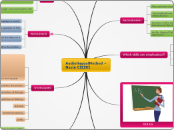jonka Nazin Ciziri 12 vuotta sitten
648
AudiolingualMethod – Nazin CİZİRİ

jonka Nazin Ciziri 12 vuotta sitten
648

Lisää tämän kaltaisia
(MORE...)
The principles of this method are:
1. Instructions are given in the target language.
2. Language forms occur within a context.
3. Students’ native language interferes as little as possible with the students’ attempts to acquire the target language.
4. Teaching is directed to provide students with a native-speaker-like model.
5. Analogy provides a better foundation for language learning than analysis.
6. Errors are carefully avoided because they lead to the formation of bad habits.
7. Positive reinforcement helps the student to develop correct habits.
8. Students are encouraged to learn to respond to both verbal and nonverbal stimuli.
9. The teacher is regarded as an orchestra leader-conducting, guiding and controlling the students’ behavior in the target language.
10. Learning a foreign language is treated on par with the native language learning.
11. A comparison between the native language and the target language is supposed to help teachers to find the areas with which their students probably experience difficulty: this is expected to help students to overcome the habit of the native language.
12. Language is not seen separated from culture. Culture is the everyday behavior of people who use the target language. One of the teachers’ responsibilities is to present information about that culture in context.
13. Students are taken to be the imitators of the teacher’s model or the tapes.
14. The dialogue is the chief means of presenting vocabulary, structures and it is learned through repetition and imitation.
15. Mimicry, memorization and pattern drills are the practice techniques that are emphasized.
16. Most of the interaction is between the teacher and the learner and it is imitated by the learner.
17. Listening and speaking are given priority in language teaching, and they precede reading and writing.
18. Correct pronunciation, stress, rhythm and intonation are emphasized.
19. The meanings of the words are derived in a linguistic and cultural context and not in isolation.
20. Audio-visual aids are used to assist the students’ ability to form new language habits.
The factor that enabled the birth of the Audio-lingual method was the outbreak of World War II, which created the need to post large number of American servicemen all over the world. It was therefore necessary to provide these soldiers with at least basic verbal communication skills. Unsurprisingly, the new method relied on the prevailing scientific methods of the time, observation and repetition, which were also admirably suited to teaching en masse. Because of the influence of the military, early versions of the audio-lingualism came to be known as the “army method.”